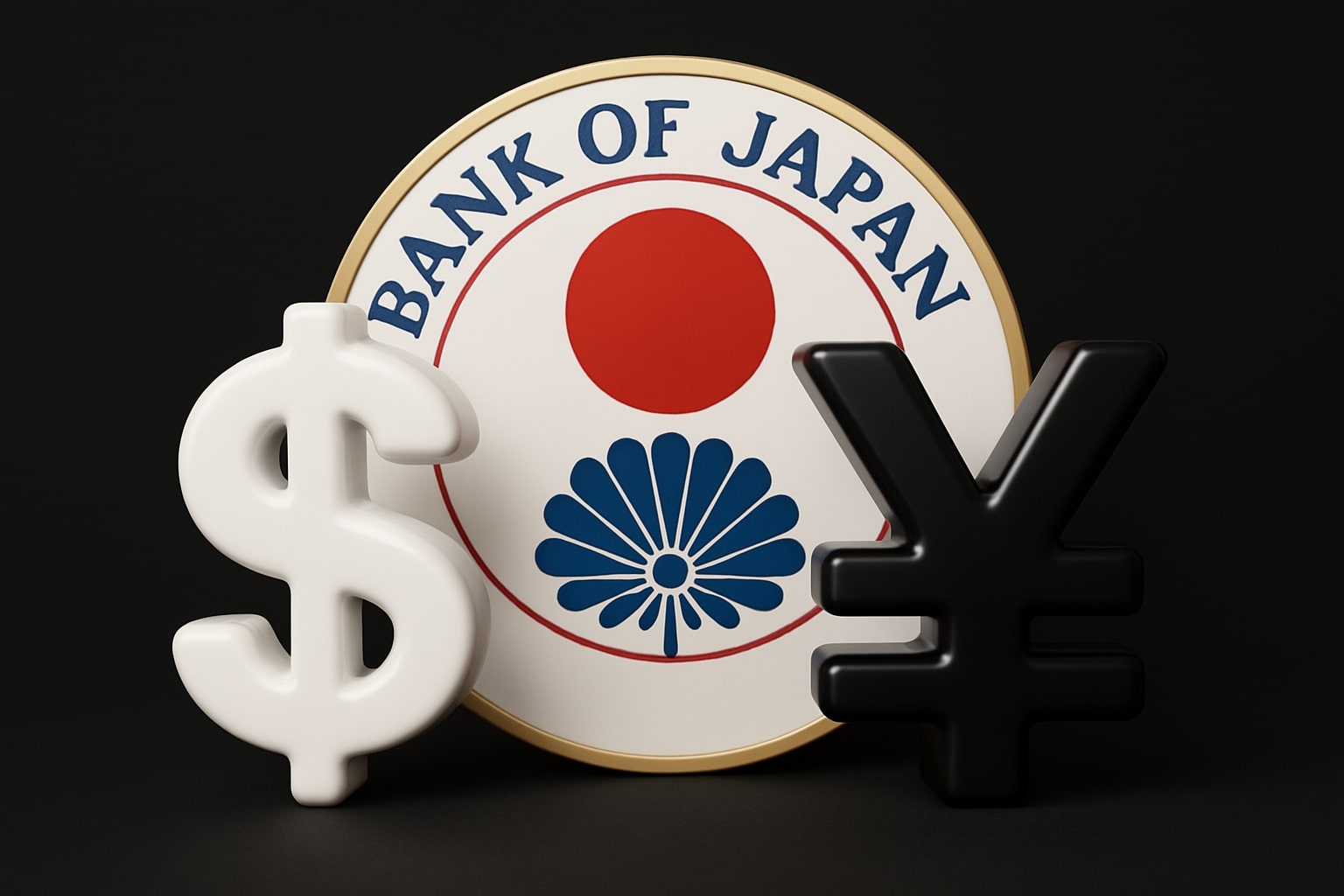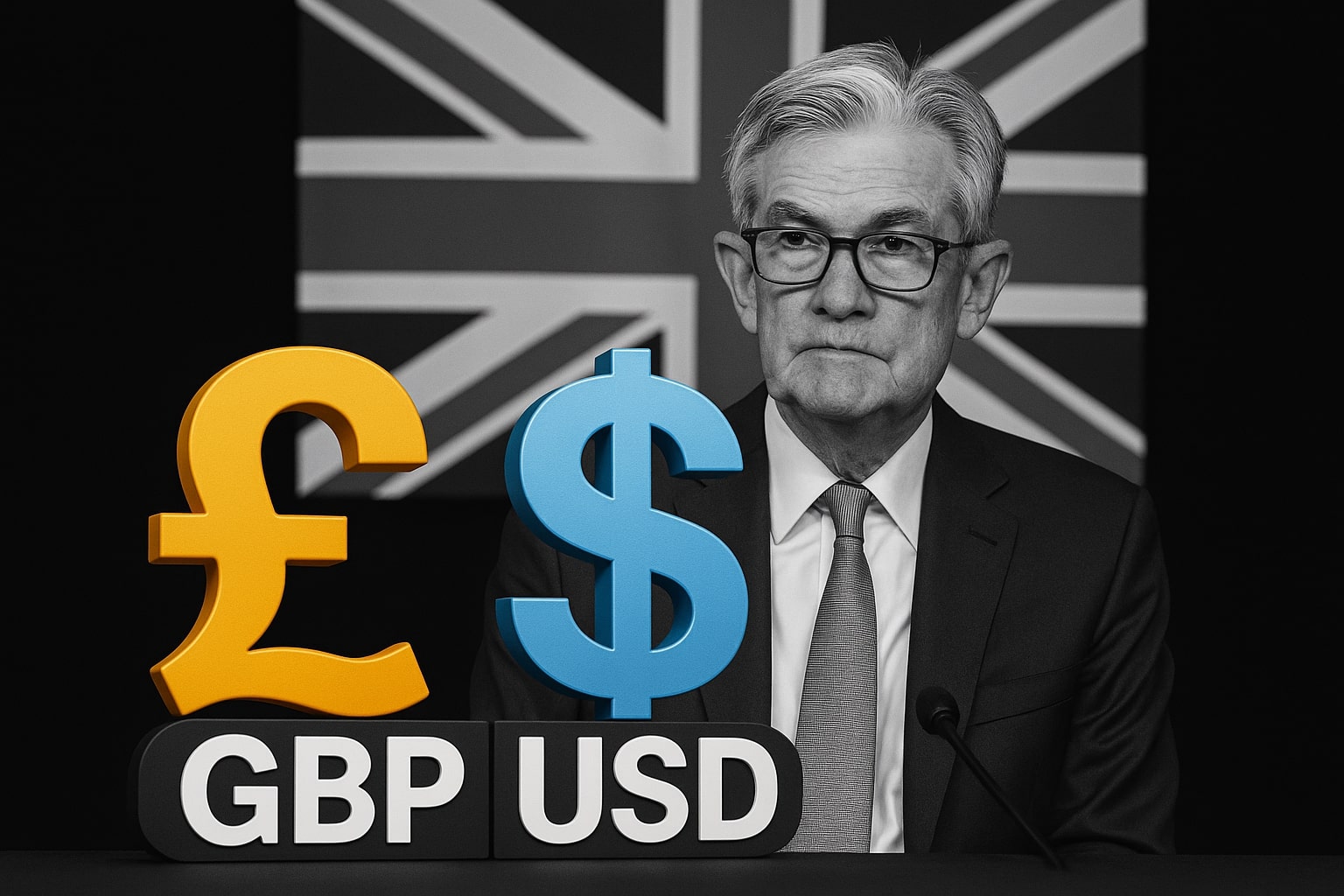
USD/JPY Price Forecast - USDJPY=X Falls to 150 as Yield Spread Breakdown, Japan Political Rift Strengthen Yen
USD/JPY trades near 150.20 after retreating from 153.28 highs, as the U.S.–Japan 10-year yield spread slips below 2.47% and Japan’s coalition split fuels yen demand | That's TradingNEWS
USD/JPY (USDJPY=X) Faces Crosswinds as Yield Spread Narrows, Fed Cut Bets Rise, and Japan’s Political Rift Fuels Yen Volatility
The USD/JPY (USDJPY=X) pair remains caught in a volatile consolidation near 150.20, fluctuating between safe-haven demand for the Japanese Yen and renewed strength in the U.S. Dollar. After peaking at 153.28 on October 10, the pair slid more than 2.2%, briefly touching 149.90, as traders reacted to shifting monetary expectations and deepening political turbulence in Japan. At the same time, a pivotal technical and macro shift — the U.S.–Japan 10-year yield spread falling below 2.47% — has begun signaling a potential end to the months-long dollar dominance that pushed the pair to multi-decade highs.
Yield Spread Breakdown Undermines USD/JPY Momentum
The breakdown in the U.S.–Japan 10-year yield differential is the most significant macro driver of the recent pullback. The spread has slipped beneath 2.47%, its lowest level since April, mirroring a decline seen between late 2024 and mid-2025 that triggered a 10% correction in the pair. As U.S. Treasury yields retreat on growing expectations of two Federal Reserve rate cuts before year-end, Japanese Government Bonds (JGBs) have held stable, narrowing the gap that once fueled relentless yen selling.
Fed fund futures now price in a 50-basis-point total reduction by December, with a 19.6% probability of a 75-basis-point cut, as policymakers like St. Louis Fed President Alberto Musalem call for a flexible approach amid slowing job growth and easing inflation. With the 10-year U.S. Treasury yield hovering near 3.97%, compared to 1.53% on Japanese JGBs, the erosion of carry trade appeal is evident. The narrowing spread typically pressures USD/JPY lower, as yield-sensitive capital shifts away from dollar carry exposure.
Political Instability in Japan Adds Layers of Volatility
While macro trends favor a stronger yen, domestic uncertainty in Japan has complicated the narrative. The collapse of the Liberal Democratic Party’s (LDP) coalition with Komeito has thrown leadership succession into turmoil, potentially ending Sanae Takaichi’s bid to become Japan’s first female prime minister. This “Takaichi Trade” — a short-yen positioning strategy premised on extended fiscal stimulus — has now unwound sharply. The resulting political vacuum could tighten fiscal discipline and strengthen the yen in the medium term.
However, investors remain wary of how this political fracture interacts with the Bank of Japan’s (BoJ) next policy decision on October 29–30. Governor Kazuo Ueda emphasized that the bank will “examine more data before making any adjustment,” suggesting policy caution rather than an immediate tightening. The market currently prices only a 10–20% probability of a rate hike, meaning even minor hawkish shifts could shock positioning and accelerate yen appreciation.
Trump’s Softer Stance on China Temporarily Lifts USD/JPY
In contrast, the U.S. side of the equation saw a short-lived rebound after President Donald Trump tempered his rhetoric toward Beijing, calling 100% tariffs on Chinese imports “unsustainable” and confirming a meeting with President Xi Jinping at the upcoming APEC Summit in South Korea. The news improved risk sentiment, driving U.S. equity futures higher and briefly pushing USD/JPY back above 150.30.
Despite this rebound, the move remains fragile. The U.S. Dollar Index (DXY) recovered from its 10-day low of 98.00 to around 98.35, but traders remain cautious as geopolitical risk and monetary policy divergence overshadow any temporary diplomatic relief. If trade talks stall or if new tariffs resurface, risk aversion could again fuel yen inflows, reinforcing downside pressure on USD/JPY.
Implied Volatility and Option Flows Point to Defensive Hedging
The JPY implied volatility index has started to rise from its nine-month low of 8.39 to 9.01, signaling an increase in demand for yen protection via options. Historically, similar upticks — like the January–February 2025 jump from 8.69 to 10.59 — preceded 8–10% corrections in the USD/JPY pair. Institutional traders appear to be positioning defensively, expecting a potential breach below the 149.00–148.50 zone, where both the 50-day moving average and gap support from October 6 converge.
The short-term structure remains technically vulnerable. The 20-day moving average at 149.75 has acted as temporary support but is on the verge of breaking, while resistance stands near 151.70, a level that capped previous rebounds. A confirmed breakdown below 149.75 would expose 148.55, while sustained closes below 148.00 could trigger a broader reversal toward 146.60, the lower boundary of the medium-term wedge pattern.
Read More
-
VOO ETF Hits $630 as Fed Shift and AI Growth Power 2026 Rally Toward $700
07.12.2025 · TradingNEWS ArchiveStocks
-
XRP ETFs XRPI & XRPR Aim for $1B Inflows as XRP Holds $2.02 Support
07.12.2025 · TradingNEWS ArchiveCrypto
-
Natural Gas Price (NG=F) Rallies to $5.29, Freezing Temperatures Spark Bullish Breakout
07.12.2025 · TradingNEWS ArchiveCommodities
-
USD/JPY Price Forecast - Dollar Extends Slide to 154 as BoJ Hawkish Pivot Drive Yen Toward 150
07.12.2025 · TradingNEWS ArchiveForex
Inflation Dynamics and BoJ’s Policy Dilemma
Japan’s macro data continues to complicate the BoJ’s path. A Reuters poll projects that Japan’s core CPI accelerated to 2.9% year-over-year in September, up from 2.7% in August, signaling that inflation remains persistent but uneven across sectors. The BoJ faces a dilemma — whether to allow further yen appreciation to counter imported inflation or maintain ultra-loose conditions to support fragile growth.
Governor Ueda’s remarks in Washington highlighted this tension, as he noted the impact of U.S. tariffs on global growth remains “delayed but real.” This statement subtly acknowledges external risks without committing to any hawkish action. For now, the market’s bias leans toward a policy hold, especially with domestic wage growth still uneven despite ongoing corporate adjustments to labor shortages.
Risk Sentiment, Safe-Haven Flows, and Global Headwinds
The yen’s resurgence also reflects its safe-haven status amid escalating geopolitical risks. Renewed U.S.–China trade frictions, a prolonged U.S. government shutdown, and Russian missile strikes on Ukrainian energy infrastructure have all reinforced defensive demand. As global equity markets waver and U.S. yields soften, capital has rotated back into the yen — a dynamic amplified by broad unwinding of dollar longs.
Moreover, the Japanese Yen (JPY) has been the strongest G10 currency this week against the euro and pound, with daily gains of 0.16% versus EUR and 0.14% versus GBP, while the USD/JPY remains slightly higher by 0.03% intraday. This reflects mixed flows — safe-haven buying balanced against residual dollar demand from corporate hedging.
Technical Outlook: USD/JPY Faces Crucial Crossroads
From a structural standpoint, USD/JPY remains trapped within a descending correction channel formed after the failed breakout above 153.00. The pattern suggests exhaustion of bullish momentum, with key support layers stacked between 149.05 and 148.55. Below this band, the next strategic level sits at 146.60, which also aligns with the March breakout pivot.
Short-term momentum oscillators continue to favor downside extension. The hourly MACD has turned negative and slipped beneath its ascending trendline, while the RSI sits near 43, showing weakening recovery strength. Should USD/JPY sustain trade below 150.00, the bias turns decisively bearish into next week. Conversely, a rebound above 151.70 could reignite a short-covering rally toward 152.45, though such a move would likely be temporary without fresh U.S. rate-supportive data.
Market Positioning and Sentiment Analysis
Institutional flow data reflects growing caution. Leveraged funds have trimmed long USD/JPY positions by over 15% since early October, according to CFTC data, while asset managers increased net yen longs modestly, anticipating potential carry unwinds. Implied volatility skew remains tilted toward yen call premiums, a sign that traders are paying up for protection against yen strength.
Retail traders, on the other hand, remain heavily long USD/JPY, accounting for nearly 70% of open positions, which historically signals a contrarian bearish setup. As volatility builds around next week’s U.S. inflation data and Japan’s parliamentary uncertainty, any sudden spike in implied volatility could accelerate a sharp repositioning toward yen dominance.
Outlook and Rating: Bearish Bias with Short-Term Volatility Risk
At 150.20, USD/JPY (USDJPY=X) stands at a technical and macro crossroads. The collapse of the U.S.–Japan yield spread, the resurgence of safe-haven flows, and domestic political instability in Tokyo all point toward a stronger yen in the short term. Yet, periodic rebounds driven by U.S. diplomatic developments and tactical covering may keep the pair volatile between 148.50 and 151.50.
Given the confluence of narrowing yield differentials, rising implied volatility, and technical breakdown signals, the outlook remains bearish, with near-term downside targets at 149.00, 148.00, and potentially 146.50 if the 20-day moving average gives way. For now, USD/JPY merits a Sell bias — reflecting a market shifting from speculative euphoria toward yield compression reality, as traders brace for Japan’s next decisive monetary and political pivot.



















